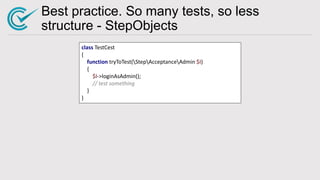Testing mit Codeception: Full-stack testing PHP framework
- 2. About me • Susann Sgorzaly, 30 • Statistician and Software developer • PHP developer for 3,5 years • currently: Developer at ITEXIA GmbH (on maternity leave) @susgo @susann_sg
- 3. Motivation • Situation in the middle of 2017: • quarterly releases • before each release: weeks of manually testing and bug fixing • Problem: • slow • expensive • late • and …
- 4. Motivation
- 5. Motivation • How to change it? • analyse the situation (testing strategy): • project manager clicks his/her way though the software • NO test scenarios list/plan à there was no strategy at this point à first of all: list of test cases (Excel list) • search a way to automate this and for the moment only this
- 6. Motivation • Searching for know-how: 1. own experiences from previous company (QuoData GmbH) • reproduce the test cases by building full navigation scenarios with CasperJS • take screenshots of all relevant pages • product owner can confirm these screenshots as correct • look at differences of the screenshots in a later run – confirm if they are correct • we had a web platform to confirm automatically created screenshots as correct
- 7. Motivation var login = { name: 'admin', pass: 'admin', }; casper.thenOpen('http://localhost'); casper.then(function() { this.fill('#user-login-form', login); }); casper.thenClick('#edit-submit'); casper.waitFor(function() { return !this.getCurrentUrl().match(RegExp( '/nach-dem-login')); }, null, function() { this.echo('[error] [casper] Failed to log in with ' + login.name + ':' + login.pass + '!', 'ERROR'); this.exit(1); });
- 9. Motivation • Searching for know-how: 1. own experiences from previous company (QuoData GmbH) • Pros at first sight: • result is easy to interpret • notices design breaks • confirmation by the product owner • Cons at first sight: • language / technology differs from product language • manually confirmation of screenshots needed
- 10. Motivation • Searching for know-how: 2. experiences from other company (portrino GmbH) • Codeception
- 11. Motivation <?php $I = new AcceptanceTester($scenario); $I->amOnPage('/site/login'); $I->see('Login', 'h1'); $I->wantTo('try to login as admin with correct credentials'); $I->fillField('input[name="LoginForm[username]"]', 'admin'); $I->fillField('input[name="LoginForm[password]"]', 'admin'); $I->click('login-button'); $I->dontSeeElement('#login-form'); $I->expectTo('see user info'); $I->see('Logout');
- 12. Motivation
- 13. Motivation • Searching for know-how: 2. experiences from other company (portrino GmbH) • Pros at first sight: • PHP (uses the software language) • simple to read • possible simple to write and easy to maintain • no manually confirmation needed • Cons at first sight: • no screenshots and therefore no design (“sexy frontend”) confirmation by the product owner
- 14. Motivation
- 16. What Is Codeception? • powerful testing framework written in PHP • inspired by BDD • only requirements are basic knowledge of PHP and the theory of automated testing • kept as simple as possible for any kind of users • powered by PHPUnit „Describe what you test and how you test it. Use PHP to write descriptions faster.“
- 17. What Does Codeception Do? • multiple approaches: • acceptance tests • functional tests • unit tests
- 18. What Kind Of Tests? – Acceptance Tests • browser emulation (Selenium / Webdriver) • can have no knowledge of the technologies • can test any website • testing done from a non-technical person • readable by humans (managers) • tests JavaScript / Ajax • stability against code changes • SLOW!
- 19. What Kind Of Tests? – Functional Tests • web request and submit to application emulation • assert against response and internal values • the person testing knows how the software works • uses different request variables to ensure the functionality of the software for nearly all cases • framework-based • still readable by humans • can‘t test JavaScript / Ajax • less slow
- 20. What Kind Of Tests? – Unit Tests • test the application core functions • single isolated tests • the testing person knows the internals of the application • only readable by IT professionals • fastest!
- 21. Codeception: How to? - Installation • Install via composer composer require “codeception/codeception“ --dev • Execute it as: ./vendor/bin/codecept
- 22. Codeception: How to? - Setup • Execute ./vendor/bin/codecept bootstrap à creates configuration file codeception.yml and tests directory and default test suites: acceptance, functional, unit app | -- tests | | -- accpeptance | | -- functional | | -- unit | | -- accpeptance.suite.yml | | -- functional.suite.yml | | -- unit.suite.yml | -- codeception.yml ..
- 23. Codeception: How to? - Configuration • example: configure acceptance test suite • edit configuration file: tests/acceptance.suite.yml actor: AcceptanceTester modules: enabled: - PhpBrowser: url: {YOUR APP'S URL} - HelperAcceptance
- 24. Side Note: Actors and Modules? • test classes use Actors to perform actions à act as a dummy user • actor classes are generated from the suite configuration • methods of actor classes are taken from Codeception Modules • each module provides predefined actions for different testing purposes • modules can be combined to fit the testing environment actor: AcceptanceTester modules: enabled: …
- 25. Side Note: PHP Browser? • doesn’t require running an actual browser • runs in any environment: only PHP and cURL are required • uses a PHP web scraper, which acts like a browser: sends a request, receives and parses the response • can’t work with JS (modals, datepickers, …) • can’t test actual visibility of elements • … • fastest way to run acceptance tests • But: not the situation a manager or customer is in
- 26. Side Note: Selenium WebDriver • requires running an actual browser (Firefox, Chrome, …) • can work with JS (modals, datepickers, …) • can test actual visibility of elements • … • slower • but: a manager or customer uses it too
- 27. Side Note: PhpBrowser vs WebDriver? • doesn’t matter what you choose at the beginning • most tests can be easily ported between the testing backends • PhpBrowser tests can be executed inside a real browser with Selenium WebDriver • you only have to change the acceptance test suite configuration file module and rebuild the AcceptanceTester class
- 28. Codeception: How to? - Configuration • Example: configure acceptance test suite • Edit configuration file: tests/acceptance.suite.yml • minimum: add your application url actor: AcceptanceTester modules: enabled: - PhpBrowser: url: {YOUR APP'S URL} - HelperAcceptance
- 29. Codeception: How to? - Generate Test • Execute ./vendor/bin/codecept generate:cest acceptance Login àgenerates new php class file LoginCest.php for class LoginCest in the folder ‚tests/acceptance‘ Note: Cest is the class based format. Codeception also supports Cept which is a scenario based format (see example from the Motivation slides)
- 30. Codeception: How to? - Write Test <?php class LoginCest { public function tryToLoginAsAdmin(AcceptanceTester $I) { $I->amOnPage('/site/login'); $I->see('Login', 'h1'); $I->wantTo('try to login as admin with correct credentials'); $I->fillField('input[name="LoginForm[username]"]', 'admin'); $I->fillField('input[name="LoginForm[password]"]', 'admin'); $I->click('login-button'); $I->dontSeeElement('#login-form'); $I->expectTo('see user info'); $I->see('Logout'); } }
- 31. Codeception: How to? - Write Test • Actions $I->fillField('input[name="LoginForm[username]"]', 'admin'); $I->click('login-button'); • Assertions $I->see('Login', 'h1'); $I->dontSeeElement('#login-form'); $I->see('Logout');
- 32. Codeception: How to? - Run Test! ./vendor/bin/codecept run --steps ./vendor/bin/codecept run --debug ./vendor/bin/codecept run acceptance ./vendor/bin/codecept run acceptance LoginCest:ensureThatLoginWorks ./vendor/bin/codecept run tests/acceptance/LoginCest.php::ensureThatLoginWorks ./vendor/bin/codecept run --xml
- 33. Codeception: How to? - Run Test!
- 34. Codeception: Basic Features • multiple backends, easily changed in configuration • Selenium, PhpBrowser, PhantomJS • elements matched by name, CSS, XPath • data clean-up after each run • integrates with different frameworks (e.g. Symfony2, Yii2, Laravel) • Dependency Injection
- 35. Codeception: Basic Features • executes PHPUnit tests • BDD-style • WebService testing via REST and SOAP is possible • generates reports: HTML, XML, JSON • Fixtures (known test data) • Database helpers • Code Coverage
- 36. Codeception - solves all my problems! YEAH!!!! Seems to be easy. Let‘s go home and write some tests…
- 37. Codeception - solves all my problems?
- 38. Codeception - solves all my problems? NO! My tests often broke! My data are unstable! So many tests, so less structure! NO! NO! NO!NO! NO! NO! NO! NO! NO! NO! NO!
- 39. Best practice. My tests often broke • use ids • use the right / a good selector (CSS, name, XPath, label) • use constants: PageObjects in Codeception
- 40. Best practice. My tests often broke • PageObjects: • represents a web page as a class • the DOM elements on that page are its properties • some basic interactions are its methods • example: ./vendor/bin/codecept generate:pageobject Login
- 41. Best practice. My tests often broke class LoginCest { public function tryToLoginAsAdmin(AcceptanceTester $I) { $I->amOnPage('/site/login'); $I->see('Login', 'h1'); $I->wantTo('try to login as admin with correct credentials'); $I->fillField('input[name="LoginForm[username]"]', 'admin'); $I->fillField('input[name="LoginForm[password]"]', 'admin'); $I->click('login-button'); $I->dontSeeElement('#login-form'); $I->expectTo('see user info'); $I->see('Logout'); } }
- 42. Best practice. My tests often broke namespace Page; class Login { // include url of current page public static $URL = '/site/login'; /** * Declare UI map for this page here. CSS or XPath allowed. */ public static $form = '#login-form'; public static $usernameField = 'input[name="LoginForm[username]"]'; public static $passwordField = 'input[name="LoginForm[password]"]'; public static $formSubmitButton = 'login-button'; }
- 43. Best practice. My tests often broke class LoginCest { public function tryToLoginAsAdmin(AcceptanceTester $I, PageLogin $loginPage) { $I->amOnPage($loginPage::$URL); $I->seeElement($loginPage::$form); $I->wantTo('try to login as admin with correct credentials'); $I->fillField($loginPage::$usernameField, 'admin'); $I->fillField($loginPage::$passwordField, 'admin'); $I->click($loginPage::$formSubmitButton); $I->dontSeeElement($loginPage::$form); $I->expectTo('see user info'); $I->see('Logout'); } }
- 44. Best practice. My data are unstable • try to search for stable elements on the website • use fixtures instead of database dumps • fixtures: • sample data for tests • data can be either generated, loaded from an array or taken from a sample database • usage with Db module: $I->haveInDatabase('posts', array('title' => My title', 'body' => The body.'));
- 45. Best practice. My data are unstable • use DataFactory module to generate the test data dynamically • uses an ORM of your application to define, save and cleanup data • should be used with ORM or Framework modules • requires package: "league/factory-muffin“
- 46. Best practice. My tests often broke <?php use LeagueFactoryMuffinFakerFacade as Faker; $fm->define(User::class)->setDefinitions([ 'name' => Faker::name(), // generate email 'email' => Faker::email(), 'body' => Faker::text(), // generate a profile and return its Id 'profile_id' => 'factory|Profile' ]); • Generation rules can be defined in a factories file
- 47. Best practice. My tests often broke modules: enabled: - Yii2: configFile: path/to/config.php - DataFactory: factories: tests/_support/factories depends: Yii2 • load factory definitions from a directory
- 48. Best practice. My data are unstable • DataFactory module actions • generate and save record: $I->have('User'); $I->have('User', ['is_active' => true]); • generate multiple records and save them: $I->haveMultiple('User', 10); • generate records (without saving): $I->make('User');
- 49. Best practice. So many tests, so less structure • test code is source code and therefore should follow the same rules • reuse code • extend AcceptanceTester class located inside the tests/_support directory • use StepObjects • use PageObjects
- 50. Best practice. So many tests, so less structure – Extend AcceptanceTester class AcceptanceTester extends CodeceptionActor { // do not ever remove this line! use _generatedAcceptanceTesterActions; public function login($name, $password) { $I = $this; $I->amOnPage('/site/login'); $I->submitForm('#login-form', [ 'input[name="LoginForm[username]"]' => $name, 'input[name="LoginForm[password]"]' => $password ]); $I->see($name, 'Logout'); } }
- 51. Best practice. So many tests, so less structure - StepObjects • groups some common functionality for a group of tests (for testing a part of a software: admin area, …) • extends AcceptanceTester class • example: ./vendor/bin/codecept generate:stepobject Admin à generate a class in tests/_support/Step/Acceptance/Admin.php
- 52. Best practice. So many tests, so less structure - StepObjects namespace StepAcceptance; class Admin extends AcceptanceTester { public function loginAsAdmin() { $I = $this; // do login } }
- 53. Best practice. So many tests, so less structure - StepObjects class TestCest { function tryToTest(StepAcceptanceAdmin $I) { $I->loginAsAdmin(); // test something } }
- 54. Codeception: Nice to have • session snapshots (for faster execution) • share cookies between tests • e.g. test user can stay logged in for other tests: • $I->saveSessionSnapshot('login‘); • $I->loadSessionSnapshot('login'); • group tests with @group annotation for test methods: • e.g. @group important • ./vendor/bin/codecept run acceptance -g important
- 55. Codeception: Nice to have • before/after annotations • example annotations • dataProvider annotations • environments • dependencies • multi session testing • …
- 57. Codeception: Summary • easy for developers but difficult for product owner • layout tests missing • should we use another tool?
- 58. Codeception: Summary • Codeception is extendable • solution: use module Visualception • see https://github.com/Codeception/VisualCeption for more information






![Motivation
var login = {
name: 'admin',
pass: 'admin',
};
casper.thenOpen('http://localhost');
casper.then(function() {
this.fill('#user-login-form', login);
});
casper.thenClick('#edit-submit');
casper.waitFor(function() {
return !this.getCurrentUrl().match(RegExp(
'/nach-dem-login'));
}, null, function() {
this.echo('[error] [casper] Failed to log
in with '
+ login.name + ':' + login.pass + '!',
'ERROR');
this.exit(1);
});](https://image.slidesharecdn.com/2018-04-19phpmeetup-codeception-181112212327/85/Testing-mit-Codeception-Full-stack-testing-PHP-framework-7-320.jpg)



![Motivation
<?php
$I = new AcceptanceTester($scenario);
$I->amOnPage('/site/login');
$I->see('Login', 'h1');
$I->wantTo('try to login as admin with correct credentials');
$I->fillField('input[name="LoginForm[username]"]', 'admin');
$I->fillField('input[name="LoginForm[password]"]', 'admin');
$I->click('login-button');
$I->dontSeeElement('#login-form');
$I->expectTo('see user info');
$I->see('Logout');](https://image.slidesharecdn.com/2018-04-19phpmeetup-codeception-181112212327/85/Testing-mit-Codeception-Full-stack-testing-PHP-framework-11-320.jpg)

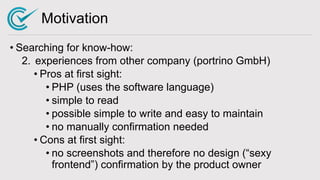




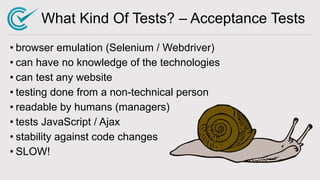

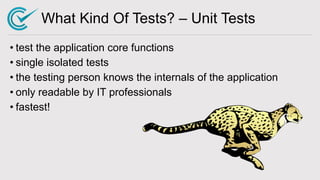


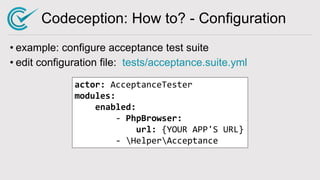


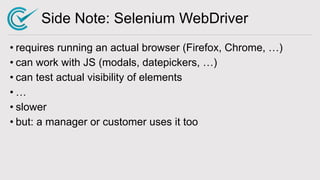



![Codeception: How to? - Write Test
<?php
class LoginCest
{
public function tryToLoginAsAdmin(AcceptanceTester $I)
{
$I->amOnPage('/site/login');
$I->see('Login', 'h1');
$I->wantTo('try to login as admin with correct credentials');
$I->fillField('input[name="LoginForm[username]"]', 'admin');
$I->fillField('input[name="LoginForm[password]"]', 'admin');
$I->click('login-button');
$I->dontSeeElement('#login-form');
$I->expectTo('see user info');
$I->see('Logout');
}
}](https://image.slidesharecdn.com/2018-04-19phpmeetup-codeception-181112212327/85/Testing-mit-Codeception-Full-stack-testing-PHP-framework-30-320.jpg)
![Codeception: How to? - Write Test
• Actions
$I->fillField('input[name="LoginForm[username]"]', 'admin');
$I->click('login-button');
• Assertions
$I->see('Login', 'h1');
$I->dontSeeElement('#login-form');
$I->see('Logout');](https://image.slidesharecdn.com/2018-04-19phpmeetup-codeception-181112212327/85/Testing-mit-Codeception-Full-stack-testing-PHP-framework-31-320.jpg)

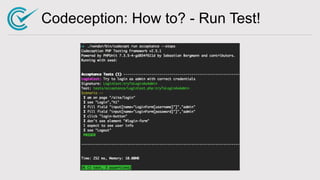







![Best practice. My tests often broke
class LoginCest
{
public function tryToLoginAsAdmin(AcceptanceTester $I)
{
$I->amOnPage('/site/login');
$I->see('Login', 'h1');
$I->wantTo('try to login as admin with correct credentials');
$I->fillField('input[name="LoginForm[username]"]', 'admin');
$I->fillField('input[name="LoginForm[password]"]', 'admin');
$I->click('login-button');
$I->dontSeeElement('#login-form');
$I->expectTo('see user info');
$I->see('Logout');
}
}](https://image.slidesharecdn.com/2018-04-19phpmeetup-codeception-181112212327/85/Testing-mit-Codeception-Full-stack-testing-PHP-framework-41-320.jpg)
![Best practice. My tests often broke
namespace Page;
class Login
{
// include url of current page
public static $URL = '/site/login';
/**
* Declare UI map for this page here. CSS or XPath allowed.
*/
public static $form = '#login-form';
public static $usernameField = 'input[name="LoginForm[username]"]';
public static $passwordField = 'input[name="LoginForm[password]"]';
public static $formSubmitButton = 'login-button';
}](https://image.slidesharecdn.com/2018-04-19phpmeetup-codeception-181112212327/85/Testing-mit-Codeception-Full-stack-testing-PHP-framework-42-320.jpg)

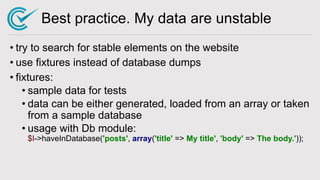

![Best practice. My tests often broke
<?php
use LeagueFactoryMuffinFakerFacade as Faker;
$fm->define(User::class)->setDefinitions([
'name' => Faker::name(),
// generate email
'email' => Faker::email(),
'body' => Faker::text(),
// generate a profile and return its Id
'profile_id' => 'factory|Profile'
]);
• Generation rules can be defined in a factories file](https://image.slidesharecdn.com/2018-04-19phpmeetup-codeception-181112212327/85/Testing-mit-Codeception-Full-stack-testing-PHP-framework-46-320.jpg)

![Best practice. My data are unstable
• DataFactory module actions
• generate and save record:
$I->have('User');
$I->have('User', ['is_active' => true]);
• generate multiple records and save them:
$I->haveMultiple('User', 10);
• generate records (without saving):
$I->make('User');](https://image.slidesharecdn.com/2018-04-19phpmeetup-codeception-181112212327/85/Testing-mit-Codeception-Full-stack-testing-PHP-framework-48-320.jpg)

![Best practice. So many tests, so less
structure – Extend AcceptanceTester
class AcceptanceTester extends CodeceptionActor
{
// do not ever remove this line!
use _generatedAcceptanceTesterActions;
public function login($name, $password)
{
$I = $this;
$I->amOnPage('/site/login');
$I->submitForm('#login-form', [
'input[name="LoginForm[username]"]' => $name,
'input[name="LoginForm[password]"]' => $password
]);
$I->see($name, 'Logout');
}
}](https://image.slidesharecdn.com/2018-04-19phpmeetup-codeception-181112212327/85/Testing-mit-Codeception-Full-stack-testing-PHP-framework-50-320.jpg)


